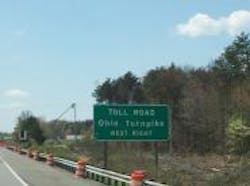Keep the speeds down, but don't blame trucking
The Ohio Turnpike Commission is considering raising the speed limit on the Turnpike. According to Marilou Johanek of the Toledo Blade, the authority wants to raise the speed limit on the Turnpike from 65 mph to 70 mph.
Mostly, I think I have to agree with Johanek, who lays out a pretty good argument against the proposal. But she does lose some credibility when she highlights the additional dangers due to faster trucks on the highway. And she takes this argument because the Turnpike authority itself uses truck efficiency as a reason for the proposed increase.
She then goes on to cite Ohio State Highway Patrol statistics showing that “collisions involving trucks and other commercial vehicles went up 32 percent in the 18 months after the speed limit was increased in 2004. During the same period, a patrol report noted, the number of accidents causing deaths or injuries involving trucks jumped 56 percent.”
The question I have is whether those numbers have since decreased. The year 2004 is a long time ago, especially in terms of safety technology, which has dramatically improved in the past six years, as we all know.
In fact, according to the National Highway Traffic Safety Administration (NHTSA), truck-involved crash fatalities in the U.S. fell 33% from 2003 to 2009, reaching the lowest levels since DOT started keeping records in 1975.
NHTSA said highway deaths due to crashes fell to 33,808 in 2009; a 9.7% decline from 37,423 deaths reported in 2008. That’s the lowest number since 1950 resulting in a fatality rate of 1.13 deaths per 100 million vehicle miles traveled (VMT) for 2009. That compares to a rate of 1.26 deaths per 100 million VMT for 2008.
Truck-involved traffic fatalities declined even more steeply in 2009, according to NHTSA - dropping 20% to 3,380 from 4,245 in 2008. Additionally, the number of truck occupant deaths decreased 26% in 2009 to 503, with truck occupant injuries falling 26% as well.
Johanek’s point about speed is valid, but her logic is off a little in this case. I don’t know what the actual truck-involved fatality rate on the Ohio Turnpike was in 2009, or even 2008 for that matter since Johanek used six-year-old statistics. I do know that in 2009, fatalities on Ohio highways dropped 14% from 2008, according to NHTSA.
Do I agree that raising the speed limit might cause undue risk on the Turnpike? I do, especially given the number of drivers – both commercial and passenger - who exceed posted speed limits by as much as 15 mph on some roads. Faster vehicles decrease reaction times and therefore increase risk.
The Turnpike Commission itself believes raising the speed limit would take more trucks off secondary roads, improving safety there, because they could cut as much as 20 minutes off their route, thereby improving delivery times. As Johanek points out, this just takes the risk of one road and puts it on another.
Here’s a much brighter idea: Keep the limits as they are and try lowering the tolls, which currently sit at $32 for a 5-axle vehicle and as much as $65 for 7-axle vehicles. And those are for E-Z Pass users – it’s even more expensive if you don’t have an E-Z Pass. Cut the toll cost in half and watch the trucks line up to use the highway and the cash start flowing for the Turnpike Commission.
